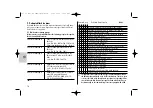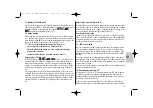
72
ķ
3.4 Auto OFF for the flash unit
To save battery power and prevent inadvertent battery drain, the flash unit is
factory-set to automatically switch to standby mode (Auto OFF) 10 minutes after
• being switched on,
• a flash is fired
• the shutter release is actuated
• the camera’s exposure metering system is switched off.
...The flash readiness indicator and the LC display are also switched off.
If the flash is manually switched on again, the last settings prior to the automatic
switch off are retained and immediately available. The flash unit can be reacti-
vated by pressing any button or by lightly depressing the shutter release (wake
up function).
The flash unit should always be turned off using the main switch
if it
is not going to be used for an extended period.
If necessary, the Auto OFF function can be set to occur after 1 minute of inactivi-
ty, or can be deactivated (see 7.9).
4 LED displays on the flash unit
4.1 Flash readiness indication
When the flash capacitor is charged, the flash readiness symbol
lights up
on the flash unit, indicating that the flash is ready to fire. This means that flash
light can be used for the next shot. Flash readiness is also transmitted to the
camera and indicated accordingly in the camera’s viewfinder (see 6).
If a shot is taken before the flash readiness indicator appears in the camera’s
viewfinder, then the flash unit will not be triggered and, if the camera has alrea-
dy switched to flash sync speed (see 11.1), the shot may have the wrong expo-
sure.
☞
4.2 Correct exposure indication
The correct exposure indication „OK“
only lights up for about 5 seconds if
the shot was correctly exposed in TTL flash mode (
,
BL,
,
BLL;
see 7)!
If no „OK“ exposure indication appears after the shot, then the shot was under-
exposed. You will need to repeat the shot with the next smaller f-number (for
example, f/8 instead of f/11) or the distance to the subject or reflecting surface
(for example, with bounce flash) will have to be reduced. Note the maximum
flash range indicated on the display of the flash unit (see 5.2). For information
on the correct exposure indicator in the camera viewfinder, also see 6.
5 Information in Display
The Nikon cameras of the Groups B, C, D und E (see Table 1) transmit the set-
tings for ISO, lens focal length (mm) and aperture to the flash unit. It calculates
the maximum flash range from the settings and their guide number. Flash mode,
range, aperture and zoom position of the main reflector are displayed in the
display of the flash unit.
If the flash unit is operated without having received data from the camera (for
example, if the camera is switched off or with a camera from Group A), only
the flash mode selected, the zoom position of the main reflector and „Zoom“ is
displayed. The displays for aperture and range only occur once the flash unit
has received the data required from the camera.
Displays for aperture and range only occur with cameras from Groups B,
C, D & E (see Table 1) if these are operated with an AF lens or a lens with
CPU!
Display illumination
Every time a button on the flash unit is pressed, the flash display illumination is
activated for 10 seconds. When a flash is fired via the camera or the hand
release
on the flash unit, the display illumination is switched off.
☞
TTL
TTL
TTL
TTL
707 47 0081.A2 48AF-1Nikon/Inh. 19.09.2007 12:42 Uhr Seite 72
















































